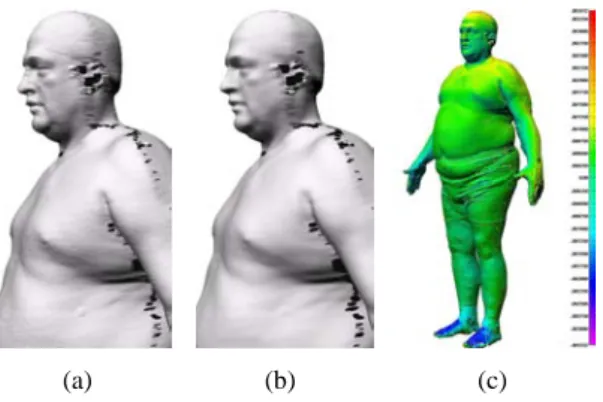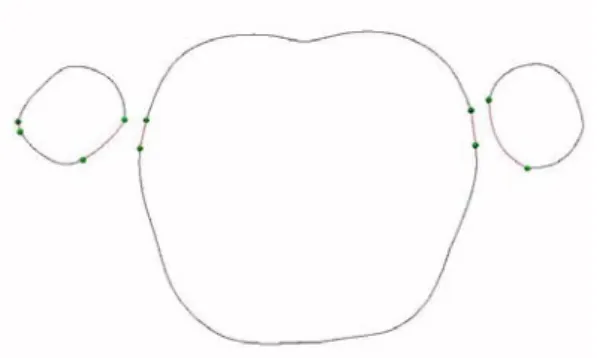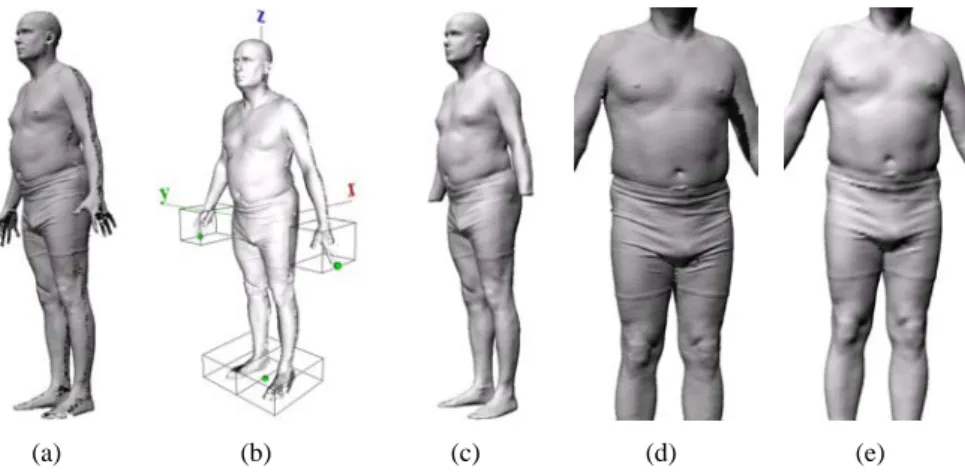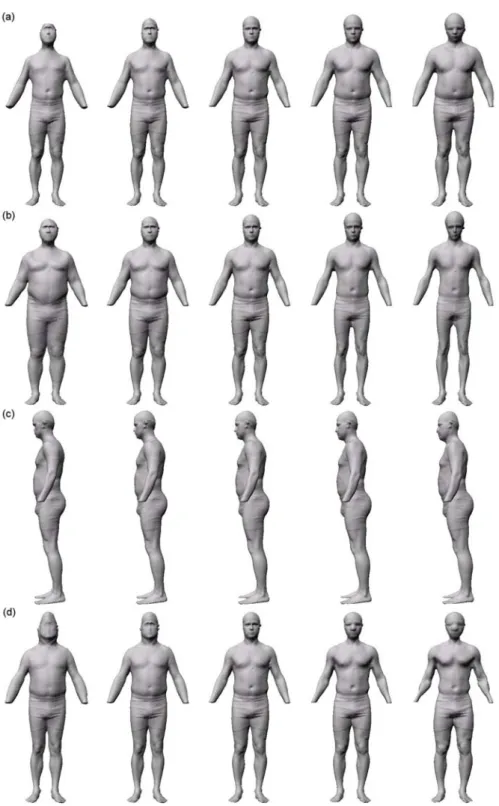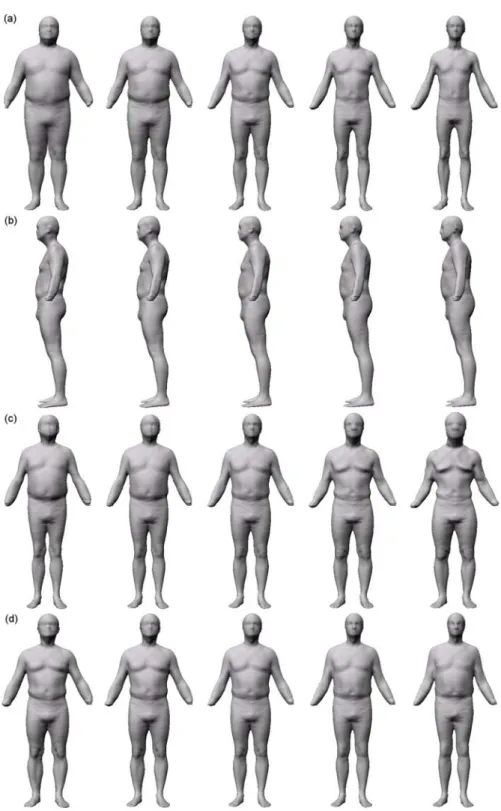Publisher’s version / Version de l'éditeur:
Vous avez des questions? Nous pouvons vous aider. Pour communiquer directement avec un auteur, consultez la
première page de la revue dans laquelle son article a été publié afin de trouver ses coordonnées. Si vous n’arrivez pas à les repérer, communiquez avec nous à PublicationsArchive-ArchivesPublications@nrc-cnrc.gc.ca.
Questions? Contact the NRC Publications Archive team at
PublicationsArchive-ArchivesPublications@nrc-cnrc.gc.ca. If you wish to email the authors directly, please see the first page of the publication for their contact information.
https://publications-cnrc.canada.ca/fra/droits
L’accès à ce site Web et l’utilisation de son contenu sont assujettis aux conditions présentées dans le site LISEZ CES CONDITIONS ATTENTIVEMENT AVANT D’UTILISER CE SITE WEB.
The 17th Annual Conference on Computer Animation and Social Agents
(CASA2004) [Proceedings], 2004
READ THESE TERMS AND CONDITIONS CAREFULLY BEFORE USING THIS WEBSITE. https://nrc-publications.canada.ca/eng/copyright
NRC Publications Archive Record / Notice des Archives des publications du CNRC :
https://nrc-publications.canada.ca/eng/view/object/?id=db09f982-918b-43f6-bd9d-8eabd775474f https://publications-cnrc.canada.ca/fra/voir/objet/?id=db09f982-918b-43f6-bd9d-8eabd775474f
NRC Publications Archive
Archives des publications du CNRC
This publication could be one of several versions: author’s original, accepted manuscript or the publisher’s version. / La version de cette publication peut être l’une des suivantes : la version prépublication de l’auteur, la version acceptée du manuscrit ou la version de l’éditeur.
Access and use of this website and the material on it are subject to the Terms and Conditions set forth at
Analysis of Human Shape Variation using Volumetric Techniques
Ben Azouz, Zouhour; Rioux, Marc; Shu, Chang; Lepage, R.
National Research Council Canada Institute for Information Technology Conseil national de recherches Canada Institut de technologie de l'information
Analysis of Human Shape Variation using
Volumetric Techniques *
Ben Azouz, Z., Rioux, M., Shu, C., Lepage, R.
July 2004
* published in The 17th Annual Conference on Computer Animation and Social Agents (CASA2004). Geneva, Switzerland. July 7-9, 2004. NRC 47147.
Copyright 2004 by
National Research Council of Canada
Permission is granted to quote short excerpts and to reproduce figures and tables from this report, provided that the source of such material is fully acknowledged.
Analysis of Human Shape Variation Using
Volumetric Techniques
Z. Ben Azouz
(1,2)Zouhour.Benazouz@nrc-cnrc.ca
M. Rioux
(1)Marc.Rioux@nrc-cnrc.ca
C. Shu
(1)Chang.Shu@nrc-cnrc.ca
R. Lepage
(2)Richard.Lepage@etsmtl.ca
(1)
National Research Council of Canada
(2)Ecole de Technologie Sup´erieure de Montr´eal
´
Abstract
Analyzing human shape variability is impor-tant for human system engineering and for animation applications where synthesizing realistic virtual humans is needed to re-create social human activities in historical and cultural context. In this paper, we present a new method for extracting main modes of variations of the human shape from a 3-D anthropomet-ric database. Previous approaches rely on anatomical landmarks. Using a volumetric representation, we show that human shape analysis can be performed despite the lack of such information. We first introduce a technique for repairing the 3-D models from the original scans. Principal components analysis is then applied to the volumetric description of a set of human models to extract dominant components of shape variability for a target population. We demonstrate good reconstructions of the original models from a reduced number of components. We provide a visualization of the main modes of human shape variation.
Keywords: {3-D Anthropometry, volumet-ric description, human body modeling}
1 Introduction
Characterizing and understanding human shape variation is traditionally the subject of anthro-pometry – the study of human body measure-ment. It is essential for better ergonomic de-sign of any products with which people inter-act such as clothing, automobiles, and work sta-tions. Recently, researchers in the computer an-imation community have increasingly realized the importance of generating realistic actors by capturing real human shapes [1].
The traditional anthropometry is based on a set of measurements corresponding to lin-ear distances between anatomical landmarks and circumference values at predefined locations. These measurements provide limited informa-tion about the human body shape [2]. Further-more, the traditional measurement, performed by hand, is a long and tedious process, requiring about 30 minutes for each subject. This presents a severe limitation for surveying a large number of subjects. The advances in surface digitization technology led to the appearance of 3-D surface anthropometry where whole body scanners are used to generate detailed human models in a few seconds.
Whole body scanners generate verbose data that cannot be used directly for shape analysis. Therefore, it is necessary to convert 3-D scans
to some form of useful representation. The key problem in analyzing human shapes from scan-ning data is in establishing correspondences be-tween models. In this paper, we obtain a cor-respondence by converting the polygonal mesh description of human models to a volumetric representation. We align 3-D scans inside a vol-ume of fixed dimensions which is sampled to a set of voxels. A human models is then charac-terized by an array of signed distances between the voxels and their nearest point on the body surface. Correspondence is achieved by com-paring for each voxel the signed distances at-tributed to different models. Surfaces are recon-structed from the volumetric description using the marching cube algorithm [3]. The advantage of the volumetric representation is that corre-spondence between different models is achieved without using feature markers.
Principal components analysis is applied to the volumetric representation to extract a re-duced number of components representing main modes of variation of the human body. These components represent an orthogonal basis of the shape space and thus human models can be char-acterized compactly by their projections onto this basis. We visualize the shape variation in-duced by the main components. This visualiza-tion is useful for understanding main modes of the human shape variation.
The reminder of this paper is organized as follows. In the next section we present a brief description of the CAESAR database. Then we review related work in human shape anal-ysis and the related work in model repairing and voxelization. Next, we describe our method to develop a representation that allows a corre-spondence between different models. Then, we present the extraction of main modes of varia-tion in the human shape space using PCA. Fi-nally, we discuss the results of our approach.
2 CAESAR Data Base
CAESAR(Civilian American and European Sur-face Anthropometry Resource) is the first 3-D surface anthropometry survey performed in the USA and Europe [4].height=4.86cm During this project, body measurements were taken from about 6000 civilians between the age of 18 and
65 in the USA, the Netherlands and Italy. Sub-jects were scanned in three postures wearing tight clothes and hair coverings. The Cyber-ware WB4 [5] and Vitronic [6] full-body scan-ners were used. Each generated 3-D models contains around 300,000 triangles. A set of 74 white markers were placed at anatomical land-marks prior to scanning. The 3D locations of these landmarks were extracted from the range data using a semi-automatic approach [7].
Our experiments are based on a set of 3-D hu-man models from the CAESAR database.
3 Related Work
In this section, we review related work in the areas of analyzing shape variability from 3-D human scans, converting surfaces to volumet-ric representations (voxelization), and model re-pairing techniques.
The major problems in using 3-D human scans for shape analysis is the large number of measured points and the lack of consistent rep-resentations between different models. A com-pact representation of human models can be found in [8] for applications related to the nav-igation and the visualization of 3-D anthropo-metric databases. The proposed description is compact but it does not allow the reconstruction of the original shape. Extended hyperquadrics were used in [9] to model human scans. Fit-ting extended hyperquadrics to 3-D objects is time consuming and a large number of coeffi-cients are required to reconstruct detailed sur-faces. Principal components analysis (PCA) has been widely used for shape analysis. For in-stance, in face recognition, PCA is used to ex-tract a reduced number of component known as
eigenfaces to represent the space of faces [10].
Applying the PCA to 3-D anthropometric data requires bringing all the models in correspon-dence to each other. The most popular approach to establish this correspondence is based on fit-ting template models to measured scans such as in [11] and [12]. Anatomical landmarks are used for guiding the deformation of template surfaces to fit the scanned data. Most of the landmarks are difficult to detect without palpat-ing the body and placpalpat-ing markers on the subjects prior to scanning. Unfortunately, this operation
is time consuming and thus will not be done in future anthropometric surveys. In this paper we focus on human shape analysis without relying on anatomical landmarks. We propose to estab-lish a correspondence between different models by converting their surfaces to a volumetric rep-resentation and analyze how the same volume is occupied by different models.
Voxelization is concerned with converting ge-ometric objects from their continuous represen-tations into a set of voxels. Early voxelization algorithms were binary, assigning 1 to the oc-cupied voxels and 0 to the unococ-cupied [13, 14]. Rendered images using binary voxelization suf-fer from aliasing. Lately, alias-free voxelization techniques were proposed. They can be classi-fied into two categories. The first one concerns filtering techniques where the problem of alias-ing is solved by low-pass filteralias-ing [14, 15]. The second category concerns distance field tech-niques that assign to each voxel of the distance to its nearest surface point [16]. This category is adequate for our application since it allows a description of the volume with a continuous function that can be used for a principal compo-nents analysis. Here, the cost of computing the signed-distance is a major concern.
Models from the CAESAR database are char-acterized by incomplete meshes due to occlu-sions and low grazing angles, as shown in fig-ure 3. In order to compute an accurate distance field, it is necessary to repair these models. Sev-eral research treated the problem of hole-filling in 3D models [17, 18]. These methods provide smooth hole filling which is not adequate for the sole of the feet where bulbous shape can be gen-erated. Moreover, these techniques can produce bridges between the two legs and in the areas under the arms.
Since general hole-filling techniques can not deal with the geometry of the human body, spe-cific model repairing techniques have been de-veloped. In [19], a toolbox for identifying holes in 3D human body scans is proposed. The basic idea is to detect and classify holes according to body segments. A potential use of the classifica-tion is to fit templates of body parts to missing areas. A library of body parts is then required. Moreover, fitting these parts to missing data is not straightforward. In the same spirit, the ap-proach proposed in [12] solves efficiently the
problem of hole filling by fitting a complete tem-plate surface to the CAESAR data. This tech-nique is based on anatomical landmarks.
We propose to repair the CAESAR models by estimating missing data from measured infor-mation using a slice based method. The human models are sliced horizontally and hole-filling is performed by transforming each slice to a set of closed curves. This step is followed by gener-ating a volumetric representation. The complete surface of a human body is extracted as an iso-surface from the volumetric representation.
4 Volumetric Representation
Converting the digitized human surface to a volumetric representation is combined with the hole-filling operation in the method we propose.
4.1 Hole-Filling
The hole-filling technique we developed is based on slicing horizontally the human mod-els and transforming each slice to a set of closed curves as shown in figure 2.
During hole-filling, the normals to the surface at each vertex around holes boundaries are used. Since the surface is particularly noisy in these areas, the models are smoothed using the Taubin filter [20] before hole-filling. This filter elim-inates the noise while minimizing distortion of the original geometry. Surface smoothing of a 3-D human model using the Taubin filter is il-lustrated in figure 1. The distribution of the dis-tance between the original and the filtered mod-els, computed using the PolyWorks [21] soft-ware, proves that there is no significant distor-tion after surface smoothing.
After filtering, repairing human models consists of the following steps:
3-D scans alignment: During the scan-ning process, subjects are asked to keep the same posture. Also, the platform of the used whole body scanners have marks where subjects should stand. Despite these precautions, 3-D scans are not sufficiently aligned. This repre-sents a source of noise that affects the shape analysis.
(a) (b) (c)
Figure 1: Surface smoothing of a 3-D human scan using Taubin filter. (a) Original model. (b) Filtered model. (c) Dis-tribution of the displacement between the original and the filtered model: the mean value is 0.4 mm and the standard deviation is 0.52 mm.
the human models in order that their centers of gravity are vertically aligned. The 3-D scans are then rotated so that the coordinate system correspond to the principal axes of their tensor of inertia. We define X, Y, and Z axes as the direction of the thickness, width and height of the human body, respectively.
Segmentation: We distinguish hands, the left foot and the right foot from the rest of the body. This segmentation is useful for two reasons. First, the CAESAR models present a severe lack of data in the hands. Therefore, scanning hands separately with an adequate resolution is required for shape analysis. Thus, for our experiments we eliminate hands. Sec-ond, for the hole filling, slices are processed differently according to the body segment they belong to. In our experiments human models in a standing posture are used. We define boxes of equal dimensions for all the models to border hands and feet. To locate the boxes for the hands, we identify tips of the middle fingers in both hands. These features correspond to extremities in the y direction as shown in figure 3(b). The boxes corresponding to both feet are located using the point of coordinates (0, 0, minimum(z)).
Converting polygonal surface to horizontal slices: The models are sliced horizontally by
intersecting planes (parallel to the XY plane)
with the edges of the surface triangles. Each slice is a set of intersection points where points belonging to the same triangle are connected with a segment. Hole boundaries are identified as points that are connected to at most one other point. Hole-filling is achieved by linking these points.
Connecting boundary points: After iden-tifying the points to be connected, we establish criteria to find the optimal way to connect them. Two points are most likely to be connected if they are close to each other and their corre-sponding normals to the surface have similar orientations. These criteria are expressed in the form of a cost function that has to be minimized in order to find the optimal connection. The cost of connecting two points p1 and p2 from
the feet is
cost(p1, p2) = kp1− p2k + (1 − cos(~n1, ~n2))
and the cost of connecting two points from the rest of the body is defined as
cost(p1, p2) = kp1− p2k ∗ (1 − cos(~n1, ~n2)).
The second function gives more importance to the normal orientation in order to minimizes bridges in areas such as the under-arms and be-tween the legs.
Additional conditions are used to differenti-ate between valid and non-valid connections. A maximum distance is set between two connected points. The value of the maximum distance de-pends on the body segments. Also, in a valid configuration, a connection should not intersect other segments from the slice unless they have a common vertex. After determining the optimal connections, points are linked with second-order Bezier curves to preserve the curvature.
4.2 Voxelization
Voxelization based on a signed distance map consists of two steps. The first step classifies each voxel as lying in the interior or the exte-rior of the body. The second step computes the distance from each voxel to its nearest surface point.
For manifold polygonal models that are wa-tertight, a voxel can be classified by counting
Figure 2: Hole-filling of a slice. Black curves correspond to original data and red curves correspond to estimated data.
the number of times that a ray with its origin at the center of the voxel intersects polygons of the model (parity count). An odd number of intersections corresponds to an interior voxel and an even number corresponds to an exterior voxel. In our implementation, voxelization is performed after slicing the surface. Therefore rays are intersected with slices rather than with the model surface.
For some slices where the data is extremely noisy, the criteria used in our hole-filling ap-proach are not sufficient to connect appropri-ately boundary points. Thus, voxels can be mis-classified. To overcome this limitation, we use different directions for scan-converting models as proposed in [22]. Each direction votes on the classification of a voxel and the majority vote is the voxel’s final classification.
Computing the accurate distance from the center of each voxel to its nearest surface point is time consuming. We used the following methods to accelerate the process:
Reducing the number of voxels for which the distance has to be computed: A fast approximation of the distance field dist is firstg
determined using the Danielson algorithm [23]. Accurate distance is then computed only for voxels that are within a certain distance from the body surface. The Danielson algorithm starts from a binary volumetric representation where voxels are classified either as feature or non-feature voxels. The algorithm computes the distance of each non-feature voxel to the nearest feature voxel by propagating the distances in a small neighborhood. In order to compute distances of both interior and exterior voxels,
the Danielson algorithm is applied twice to generate an estimate distance for each voxel. During the first pass, feature voxels correspond to interior and surface voxels while in the sec-ond pass feature voxels correspsec-ond to exterior and surface voxels.
Computing distance to the nearest seg-ment of curve rather than the nearest polygon of a surface: Before voxelization, polygonal models are converted to slices. Each slice is a set of connected segments. This fact is useful since computing the distance to a segment is faster than computing the distance to a triangle.
Reducing the number of segments which the distance has to be computed with: For each
voxel V we start by identifying the distance ds to the closest segments from the same slice. Only segments that are inside a square around V and having a diagonal equal to 2 dist areg
considered. After identifying ds, segments from other slices that are inside a cube around V and having a diagonal equal to 2ds are considered.
Positive distances are assigned to interior voxels and negative distances are assigned to ex-terior voxels. A complete surface model is then extracted from the volumetric description using the marching cube algorithm [3].
Figure 3 illustrates a human model after hole-filling. The surface is extracted from a volumet-ric representation with a sampling rate of 8mm. The result shows that most of the holes in the original models are properly filled except for ar-eas such as the ears where most of the informa-tion is missing.
5 Principal Component Analysis
Principal component analysis (PCA) is used to extract a reduced number of components that span a high variability percentage in the human shape space. These components correspond to the main modes of shape variation within a given population.
In order to apply the PCA, human models are converted to a vector form ~Ψ where each ele-ment represent the signed distance of a voxel to the model’s surface. The average over a set of
(a) (b) (c) (d) (e)
Figure 3: Hole-filling of the CAESAR models. (a) Original model. (b) Segmentation of the hands and the feet of a human model. (c) Human model after hole filling and eliminating the hands. (d) Details of holes in the original model. (e) Details of repairing some of the difficult areas such as the underarm and between the legs.
N models is given by: ¯Ψ = N1 PN
i=1Ψ~i.
De-viation vectors ~Φi = ~Ψi − ¯Ψ are arranged in a
matrix A = [~Φ1Φ~2....~ΦN]. The PCA of the
ma-trix A generates a set of non-correlated eigen-vectors ~ui and their corresponding variances λi.
The eignevectors are sorted in decreasing order of their variances. Any vector ~Φi can be
ap-proximated as follows: ~Φi ≈PMj=1cij~uj where
0 ≤ M ≤ N and cij = ~Φi · ~uj are the
co-efficients of similarity of the model with each eigenvector. The quality of reconstruction can be evaluated by the fraction PM
i=1λi/PNi=1λi
representing the percentage of variance spanned by the set of eigenvectors used in the reconstruc-tion.
We applied the PCA on a set of 300 scans of males in a standing posture. The result shows that the first 40 eigenvectors span 92% of the variability of the studied data set. Figure 4 illus-trates that the shape of a human body is globally reconstructed from only 40 main components. Thus the coefficients (cij) of similarities of 3-D
scans with a set of main components is a com-pact representation that contains most of the in-formation about the original shape. This repre-sentation can be considered as a generalisation of the concept proposed by Sheldon [24] where three components, endomorphy(soft roundness in the body), mesomorphy (hardness and muscu-larity) and ectomorphy(linearity and skinnines) are proposed to characterize human body.
Visualizing the shape variation induced by the main components associates an intuitive
mean-(a) (b) (c)
Figure 4: Reconstruction of a human model from a reduced number of compo-nents. (a) Original model. (b) Model obtained after hole filling. (c) Approx-imation of the original model using 40 main components.
ing of these components which provides a better understanding of shape variability within a pop-ulation. The models illustrated in Figure 5 are synthesized using the projection of a captured model into the basis of the extracted eigenvec-tors. For each row, models are generated by varying only the coefficient of similarity of the original model with the corresponding compo-nent. The main modes of variation are visu-alized in decreasing order of the percentage of variability they reperesent in the population un-der study.
The first component is obviously correlated to the height and the second one is highly corre-lated to the weight. This result is consistent with traditional anthropometry knowledge where the
height and weight are considered main measure-ments to differentiate between human bodies. Some of the components, such as the third one, reflect posture variation. This observation could be interpreted as a random posture variation among subjects being digitized. But, it could also be interpreted as the natural neutral posture of the subject which reveals state of mind and character. The fourth component reflects a vari-ability of muscularity which is consistent with the qualitative observation made by Sheldon us-ing photographs. The extracted component re-veals though, all the subtle changes related to this variability such as the arcing of the arms and the legs.
The visual interpretation of the main com-ponents is useful for generating virtual humans from real ones. For instance, increasing the co-efficient of similarity with the fourth component will generate a virtual model that is more mus-cular than the original model.
The synthesized models have for the most part a realistic appearance. Artifacts that appear mainly in the head and the arms are related to two different reasons. The first reason is the use of signed distance. In fact a linear combination of surfaces characterized by a distance field de-scription is only an approximation of the actual linear combination of these surfaces. The ap-proximation is more accurate if there is align-ment between different models. Artifacts are also due to the fact that some of the generated models lie outside the space of human shape spanned by the set of human scans used to ex-tract the main components.
In order to isolate shape variation from height variation, we re-applied the PCA on the same set of models after normalizing their heights. Us-ing the signed distance after normalization pro-vides a better correspondence between different models. Figure 6 visualizes the main modes of shape variation extracted after height normaliza-tion. The first component is highly correlated to the weight. We can see that the third component, related to the variation of mass distribution and muscularity, is consistent with the fourth com-ponent generated using human models without height normalization.
6 Conclusion
In this paper, we propose the use of volumet-ric representation of 3-D human models based on signed-distance for shape analysis. This rep-resentation provides a correspondence between different models without using landmarks. Prin-cipal component analysis is applied to the vol-umetric representation of a set of 3-D scans from the CAESAR database. The PCA gen-erates a reduced number of components that form an orthonormal basis of the human shape space. Characterizing human models by their coefficients of similarity to these components provides a compact representation that encloses most of the shape information. This description can be used to generate virtual humans that are for the most part realistic except for the head and the hands where additional processing is re-quired. The compact description generated by the PCA is useful for anthropometric applica-tions to extract representative cases from a given population.
References
[1] N. Magnenat-Thalmann and H. Seo. Au-tomatic Modeling of Animatable Virtual Humans- A Survey. Fourth International
Conference on 3-D Digital Imaging and Modeling, IEEE Computer Society, pages
2–10, October 2003.
[2] K.M. Robinette, M.W. Vannier, M. Ri-oux, and P.R.M. Jones. 3-D sur-face anthropometry: Review of technolo-gies = L’anthropom´etrie de surface en troi dimensions: examen des technolo-gies. In Neuilly-sur-Seine: North At-lantic Treaty Organization Advisory Group for Aerospace Rearch & Development, Aerospace Medical Panel, 1997.
[3] W.E. Lorenson and H.E. Cline. March-ing Cubes: A High Resolution 3-D Sur-face Construction Algorithm. Computer Graphics, 21(3), July 1987.
[4] K.M. Robinette, H. Daanen, and E.Paquet. The Caesar Project: A 3-D Surface An-thropometry Survey. Second International
Conference on 3-D Digital Imaging and Modeling, pages 380–386, 1999. [5] Cyberware Inc. http://www. cyberware.com. [6] Vitronic Inc. http://www. vitronic.com.
[7] D. Burnsides, M. Boehmer, and K.M. Robinette. 3-D Landmark Detection and Identification in the Caesar Project. Third
International Conference on 3-D Digital Imaging and Modeling, pages 393–398,
2001.
[8] E. Paquet, K.M. Robinette, and M. Ri-oux. Management of Three-dimentional and Anthropometric Databases: Alexan-dria and Cleopatra. Journal of Electronic
Imaging, 9(4), 2000.
[9] Z. Ben Azouz, M. Rioux, R. Lepage, and C. Shu. Compact Description of Hu-man Body Shape Using Extended Hyper-quadrics. International Ergonomics
Asso-ciation XVth Triennial Congress, August
2003.
[10] M. Kirby and L. Sirovich. Application of the Karhunen-Loeve Procedure for the Characterisation of Human Faces. IEEE
Transactions on Pattern Analysis and Ma-chine Intelligence, 12(1):103–108, 1990.
[11] H. Seo and N. Magnenat-Thalmann. An Automatic Modeling of Human Bodies from Sizing Parameters. SIGGRAPH
Sym-posium on Interactive 3D Graphics, pages
19–26, July 2003.
[12] B. Allen, B. Curless, and Z. popovi´c. The Space of Human Body Shapes: Recon-struction and Parametrisation from Range Scans. ACM SIGGRAPH’2003, July 2003. [13] A. Kaufman. An Algorithm for 3D Scan Conversion of Polygons.
EUROGRAPH-ICS’87, pages 197–208, August 2000.
[14] A. Kaufman. Volume Visualization. IEEE Computer Society Press, 2000.
[15] S.W. Wang and A. Kaufman. Volume Sampled Voxelization of Geometric Prim-itives. Visualisation’93, pages 78–84, Oc-tober 1993.
[16] M.W. Jones. The Production of Vol-ume Data from Triangular Meshes Using Voxelization. Computer Graphics Forum, 15(5):311–318, December 1996.
[17] J. Davis, S.R. Marschner, M. Garr, and M. Levoy. Filling Holes in Complex Sur-faces Using Volumetric Diffusion. Proc.
First International Symposium on 3D Data Processing, Visualization, Transmission,
2002.
[18] J.C. Carr, R.K. Beatson, J.B. Cherrie, T.J. Mitchell, W.R. Fright, B.C. McCal-lum, and T.R. Evans. Reconstruction and Representation of 3D Objects with Ra-dial Basis Functions. Computer Graph-ics Proceedings, Annual Conference Se-ries(SIGGRAPH’2001, pages 67–76,
Au-gust 2001.
[19] M.V. Stralen, H.A.M. Daanen, and J.W.H. Tangelder. A Tool Box to Identify Holes in 3D Human Body Scans. Interna-tional Ergonomics Association XVth Trien-nial Congress, August 2003.
[20] G. Taubin. Geometric Signal Process-ing on Polygonal Meshes.
EUROGRAPH-ICS’2000, 2000.
[21] InnovMetric Inc. http://www. innovmetric.com.
[22] F.S. Nooruddin and G. Turk. The Pro-duction of Volume Data from Triangular Meshes Using Voxelization. IEEE
Trans-actions on Visualization and Computer Graphics, 9(2):191–205, June 2003.
[23] P-ES. Danielsson. Euclidean Distance Mapping. Workshop on Volume
Visualiza-tion, 14:227–248, July 1980.
[24] W.H. Sheldon, S.S. Stevens, and W.B. Tucker. The Varieties of Human Physique. Harper and Brothers Publishers, New York, 1940.
Figure 5: Shape variation induced by some of the main components (components are sorted in de-creasing order of their variances). (a) The first component is correlated to the height. (b) The second component is correlated to the weight and the height. (c) The third component reflects a posture variation. (d) The fourth component correspond to a variation of muscu-larity.
Figure 6: Shape variation induced by some of the main components after height normalization (com-ponents are sorted in decreasing order of their variances). (a) The first component is cor-related to the weight. (b) The second component reflects a posture variation. (c) The third component correspond to a variation of muscularity. (d) The fourth component correspond to a variation of mass distribution between the torso and the legs and a variation in the arms position.
